Introduction
Color is one of the main contributors to the overall palatability of food. Whether raw or cooked, the impact of color on consumer preference and purchase intention for food is highly expected. The psychological impact of food color is an important consideration for food manufacturers because it can affect the palatability and marketability of products (Spence, 2015). Thus, innovations and the development of food colorants will always be relevant in the food industry.
Meat color is primarily determined by the content and chemical state of myoglobin (Mb), a sarcomeric protein (Suman and Joseph, 2013). Depending on the immediate reactive elements present, the oxidation or reduction of iron in the Mb complex could easily trigger a color change (Mancini and Hunt, 2005). The typical red color of meat is the result of the binding of oxygen to Mb. It is usually regarded as a color signifying freshness and high quality of raw meat and meat products. The variation from this notable meat color is often transcribed with agedness and inferior quality.
The unraveling of meat biochemistry has led to the gradual development of methods for assessing the sensorial acceptability (e.g., color, texture, and taste) of meat and meat products. Among these methods is the development of colorants aimed to retain or improve the color of meat and meat products. However, the discovery of the potential dangers of some, if not all, synthetic food colorants (e.g., Amaranth S, Ponceau, etc.), particularly their association with carcinogenic, genotoxic, and neurotoxic effects, has been noted (Kobylewski and Jacobson, 2012). Due to these food safety concerns, the call for safer alternatives has led to the sourcing of natural food colorants that offer stability, sustainability, and cost-effectiveness (Novais et al., 2022).
Cultivated meat and meat analogues are types of novel foods ideally improved using colorants to achieve a similar color to their conventional counterparts. Color changes during storage and market display could result in decreased consumer acceptability and, in turn, potential profit loss and food wastage. Therefore, methods for retaining or improving the color characteristics of meat analogues have been developed to resolve these issues (Ryu et al., 2023). The development of colorants and their applicability to novel foods could further improve product acceptability, leading to improved consumer experience and product profitability. This review focuses on the recent methods and colorants used for the color development and improvement of meat-inspired novel foods.
Novel Foods and Their Colors
Cultivated meat is laboratory-grown meat produced by culturing muscle precursor cells and other meat-relevant cell types so that following their proliferation and differentiation processes, they are ultimately transformed into edible, sustainable, and ethically-sound meat. Currently, two companies (Upside Foods and Good Meat) have secured approval for the commercialization of cultured chicken meat (Mariano et al., 2023). Cultivated meat is classified and regulated under the “Novel Foods” standards worldwide, considering its nature of production (GFI APAC, 2023).
In terms of color, the lack of Mb in raw cultivated meats—a result of the suppression of Mb under ambient oxygen conditions—calls for techniques to improve its pale color to achieve a coloration near that of conventional meat types (Fraeye et al., 2020). Several strategies related to cultivated meat color improvement have been reported which either target color change during cell mass production or post-cell mass production. Color improvement of cultivated meat during cell mass production could include methods and/or materials that either directly or indirectly affect the visual impact of the raw outputs. Simsa et al. (2019) showed that the supplementation of Mb or hemoglobin (Hb) can improve the resulting color of raw and cooked cultured beef with prolonged incubation time. However, the use of animal-derived components, such as blood-derived proteins, either for coloration or as a source of growth factors, for cultivated meat production is discouraged (Reiss et al., 2021). Meanwhile, the possibility of generating color-enhanced meat products through cell culture by genetically engineering the endogenous expression of non-native carotenoids into primary bovine skeletal muscle cells was demonstrated (Stout and Kaplan, 2022). Additionally, Ong et al. (2021) harnessed the color-changing properties of jackfruit-based scaffolds for porcine myoblasts to imitate the characteristic meat browning of conventional meat while cooking. On the other hand, Yen et al. (2023) mimicked meat marbling using fat replacers derived from plant-based oleogels, an example of post-production processing for cultivated meat.
Due to the infancy of cultivated meat technology, cultivated meat companies and other academic reports do not disclose specific information on the color development of cultured meat products brought about by patentability of technology and company confidentiality. Also, the prioritization of cell line establishment, development of mass production methods, improvement of scaffolding strategies, and development of serum-free media seems logical, considering that majority of the production cost is incurred during cell mass production. Given this point, the improvement of sensorial characteristics is reserved until efficient cell mass production is achieved.
Meat analogues have been developed as an alternative to conventional meat and are generally categorized into plant-, insect- and microbial biomass-based, according to the main component of the products. Ultimately, meat analogues must provide meat-like sensorial characteristics but without conventional livestock meat. The attitude toward novel foods, generally rooted in the perception of protein sources, needs to be addressed by overcoming the challenges of increasing the acceptability of these products (Deroy et al., 2015; Schouteten et al., 2016). This section presents the recent developments in meat analogues, focusing on the currently reported technologies and colorants for product development.
There is a wide variety of plant proteins that can be used in the production of meat analogues. Common sources of these proteins include soybean, wheat, pea, and other high protein-producing plants that can be converted into food materials (Ahmad et al., 2022; Kumar et al., 2017). Although deemed as a healthier option, plant-derived components tend to impart a bitter, astringent, and beany flavor, which can lower the sensorial acceptability of meat analogues into which they are incorporated (Kumar et al., 2017; Wang et al., 2022). Thus, efforts are to be made to control these unfavorable characteristics.
Given that the goal of plant-based meat is to simulate conventional meat, the raw and cooked product color is another important consideration for improving overall acceptability. Raw plant-based meats often have a yellowish color, far from the conventional CIE a* of conventional meat. Many commercial colorants, natural and synthetic, can be used to improve the color of plant-based meat. Impossible Food launched a plant-based beef patty with a nearly authentic color to conventional beef patties by incorporating heme proteins from genetically modified yeast (McDermott, 2021). However, taboos around genetic modifications tend to affect product perception and acceptability. For this reason, a plethora of research has ventured into discovering natural pigments for plant-based meat alternatives in line with the growing inclination for cheap and safe naturally sourced products. Bakhsh et al. (2023) recently showed different pigment (e.g.; anthocyanin, betalain, chlorophyl, etc.) sources (e.g., paprika, monascus, grape, red cabbage, etc.) that could be used for meat alternatives. Plant-based patty containing monascus red showed the highest CIE a* score in raw (25.15±0.39), steamed (20.63±0.85), and cooked (19.26±1.60) categories and were significantly higher than the control beef patty. Meanwhile, paprika (10.42±0.45) was the nearest to the CIE a* of cooked beef patty (10.20±1.29). Overall, the study explored multiple pigment sources which could aid in the formulation of meat analogues.
Currently, numerous plant-based meat companies have already commercialized their products. As a prerequisite for commercializing novel foods, labeling, which includes the components used in the production of the final product, such as natural and synthetic additives, provides the information necessary to assess its safety and truthfulness of claims. Common among product labels is the declaration of coloring agents used which could guide consumers perception towards the product.
Entomophagy, the consumption of insects as part of the diet, has been practiced in most regions of the world even prior to the coining of the term (Evans et al., 2015). The increasing interest in consuming insects, whether processed or in actual form, continues to present opportunities to develop their overall characteristics as food to overcome the fear or disgust toward entomophagy (Clarkson et al., 2019). Technologies have been developed to transform insects into unrecognizable forms, such as flours and powders (Melgar-Lalanne et al., 2019). Additionally, bleaching pre-treatment for edible insects results in the removal of natural pigments of insects to resemble a white-to-yellowish color (Triunfo et al., 2022). Therefore, coloring pigments are needed to compensate for the objective meat color. However, research on the improvement of sensorial characteristics of insect-based meat analogues seems to be lacking compared to the numerous publications dedicated to plant-based meat production. This is evident in research and reports that make use of insect-based flours or powders as additives, not as the major component of meat analogues (Foreman, 2023; Neo, 2021). Jones (2023) reviewed that the production of insect powders is energy- and labor-intensive, resulting in greater price disparity compared to chicken, tofu, conventional beef, and vegetables. More importantly, insect farming still has welfare issues, which are mainly centered around the sentience and cognition of insects. However, future developments may use insect protein as a major component once scale-up of production and other challenges are addressed. Once reached, the improvement of sensorial characteristics, including coloration, of insect-based meat analogues could take place.
Another popular meat analogue is mycoprotein-based food. Edible fungi have been part of the human diet for time immemorial and have a long history of use as pharmaceuticals. Advancements in fermentation technology have allowed the biomass production of fungal mycelia. The biomass is then processed, which includes dewatering and drying, followed by adding binders, flavors, and colorants to achieve meat-like characteristics. A popular commercial mycoprotein-based meat analogue is based on the biomass of Fusarium venenatum (PTA-2684), which can be processed into meat-inspired products, including those that are manufactured from chicken or beef (Fellows, 2009; Wiebe, 2002). Mycoprotein pastes are often described as light in color. Therefore, the addition of spices and colorants is important to simulate the heme color of conventional meat (Hashempour-Baltork et al., 2023).
Potential Colorants for Novel Foods
There is an array of food colorants commercially available for cultured meat and meat analogues owing to years of research to overcome meat color deterioration and improve the sensorial acceptability of meat-derived products. In this section, products and research related to natural and synthetic food colorants will be explored and highlighted to assist in the selection of colorants for meat-inspired novel foods, such as cultured meat and meat analogues.
Studies on synthetic colorants in meat and meat products are more focused on their detection rather than exploration of their practical use. The negative connotation of the application of synthetic colorants to meat products began with the discovery of their adverse effects on human and animal health when consumed at unsafe levels (Gupta et al., 2019; Kobylewski and Jacobson, 2012; Miller et al., 2022). However, food regulatory agencies still acknowledge and allow the use of synthetic colorants, as seen in the guidelines on the application levels and specific conditions of use (McAvoy, 2014). In the United States, the Federal Food, Drug, and Cosmetic Act (FD&C Act) guides the regulation of food dyes and colorants. While this Act has been standing, the stricter regulation of synthetic colorants compared to natural pigments somehow provides a disadvantage in using synthetic colorants, given that natural colorants are exempted from Food and Drug Administration (FDA) regulation (Simon et al., 2017).
Cultured meat and meat analogues undergo a series of physical and chemical changes as components are mixed and engineered to formulate and design a product with meat-like characteristics. During processing, raw materials (natural or synthetic) contribute to the changes (e.g., color, pH, and water holding capacity) that can affect the final characteristics of the product, particularly the color. Synthetic colorants are known to be cheap, light- and pH-resistant, and color-stable, which makes them suitable color additives for highly processed foods, such as meat alternatives. Some of the common synthetic colorants used in meat products include Amaranth S, Ponceau, Allura Red, Carmoisine, Erythrosine, and Sudan, which are regulated dyes due to their potential health adverse reactions (Iammarino et al., 2019). Potential synthetic colorants for cultured meat and meat analogues along with their acceptable daily intake (ADI) are the following: Carmoisine (ADI: 0–4 mg/kg), Ponceau 4R (ADI: 0.7 mg/kg), Erythrosine (ADI: 0–0.1 mg/kg), and Allura Red [ADI: 0–7 mg/kg; The European Food Safety Authority (EFSA) Panel on Food Additives and Nutrient Sources Added to Food, 2009a; EFSA Panel on Food Additives and Nutrient Sources Added to Food, 2009b; EFSA Panel on Food Additives and Nutrient Sources Added to Food, 2009c; EFSA Panel on Food Additives and Nutrient Sources Added to Food, 2011]. However, the use of these synthetic colorants should be carefully considered with regard to consumer perception toward the inclusion of these colorants, which could affect the acceptability and safety of cultured meat and meat analogues. Fig. 1 shows the result of surveying online shopping sites (Amazon and Plant X) selling plant-based meat analogues. A total of 49 meat analogue companies declared colorants in their product labels, but only eight companies revealed the inclusion of synthetic colorants, such as Titanium dioxide and Caramel color. Other synthetic colorants used include FD&C Red, Iron oxide, and Vitamin B12 (cyanocobalamin; Fig. 1). Although colorants used were identified, specific amounts of colorant used in the product were not disclosed.
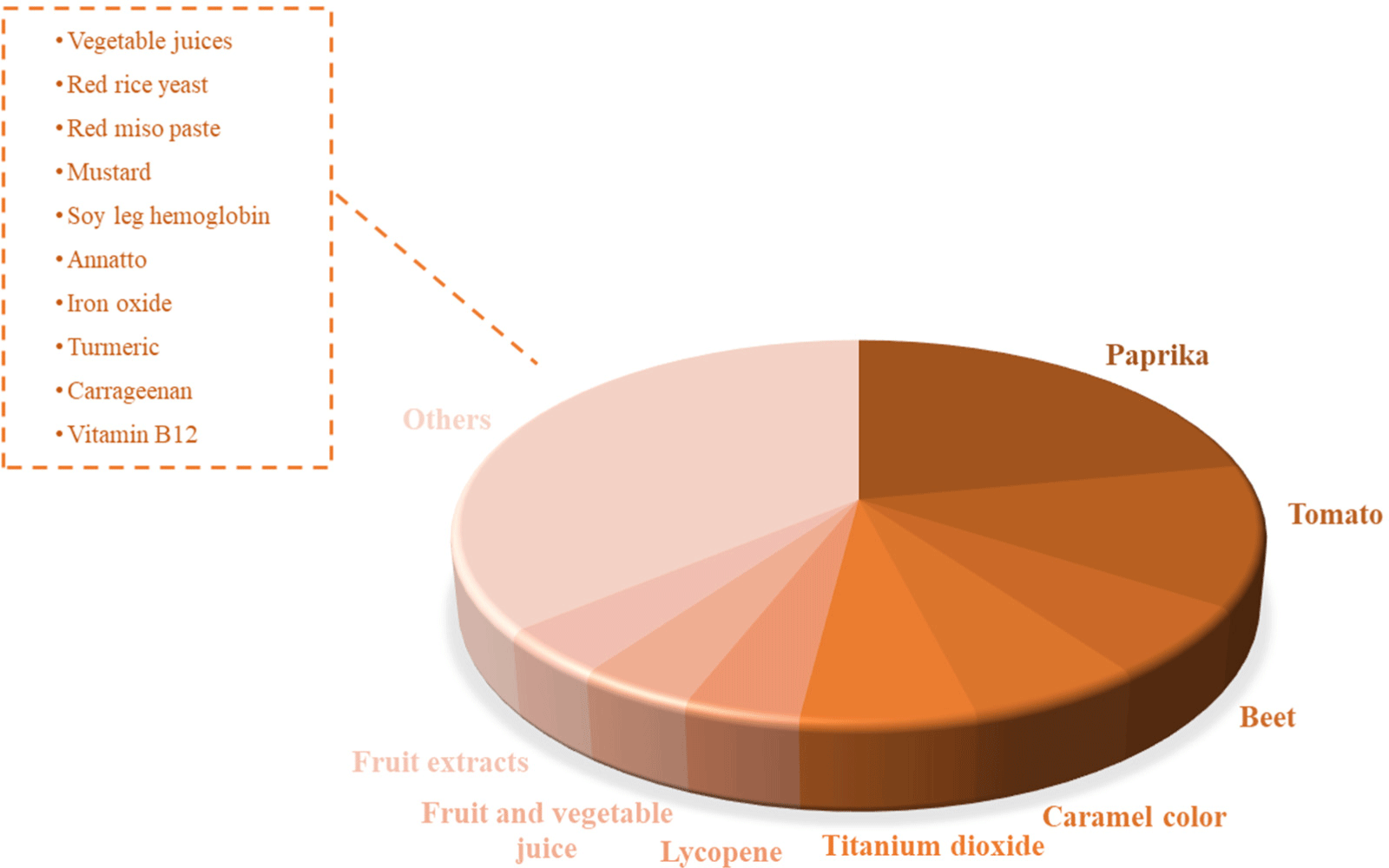
As an alternative to synthetic colorants, pigments from natural resources, mainly from plants, have been discovered and are still being developed. Unlike synthetic colorants, these natural pigments are exempt from the arduous process of dye certification as a food additive, given that plant-based dyes are commonly produced from edible plants rich in colored metabolites. Most food color sensory assessments are guided by CIE L*, CIE a*, and CIE b* parameters using either a colorimeter or spectrometer as a source of empirical data, then followed by subjective assessments by consumers and/or professionals. Altogether, food coloration is systematically achieved via guided formulations based on empirical data and consumer preferences.
Commercially available meat analogues from diverse companies could be purchased either online or in markets. The availability of product labels provides the opportunity for consumers to scrutinize the products in advance. As shown in Fig. 1, the majority of commercial plant-based meat uses plant-sourced colorants, including paprika, tomato (paste or powder), beet juice, and lycopene, with paprika being the most used colorant. Some products vaguely declared colorants as fruit extracts, fruit and vegetable juice, and vegetable juices, while other natural colorants include red rice yeast, red miso paste, red radish, soy leghemoglobin, annatto, turmeric, and carrageenan, directed to imitate the CIE a* of meat and meat products. However, the amount of the specific colorants used among the products was not disclosed. Therefore, imitating the CIE a* of these products could be based on experiments to determine the optimal amount of colorant to be used.
Accordingly, research has been published to discover methods and colorants to improve the sensorial characteristics of meat analogues. Table 1 shows recent research that includes color as a parameter in improving meat analogues. Overall, most of the colorants are natural pigments dominated by the use of beets or paprika. Other techniques used to induce coloration include the addition of plant-based replacers, heme proteins (Hb and Mb), decompartmentalization, Haematococcus pluvialis, ohmic cooking, and color-enhancing additives, such as xylose, laccase, pectin, and lactoferrin (Bakhsh et al., 2022; Huang et al., 2024; Jung et al., 2022; Liu et al., 2023; Ong et al., 2021; Sakai et al., 2022; Simsa et al., 2019; Wen et al., 2022; Xia et al., 2022; Yen et al., 2023). Although the usual color of focus for meat analogues is meat-like red, the cooked coloration was also given importance.
| Meat alternative category | Research | Colorant/Method used | Results | References |
|---|---|---|---|---|
| Cell-cultivated meat | Cultured meat platform developed through the structuring of edible microcarrier-derived microtissues with oleogel-based fat substitute | Plant-based fat replacer | - Darker color of raw cultured meat prototypes compared to raw beef was observed - Cooking resulted in further darkening attributed to the Maillard reaction  |
Adapted from Yen et al. (2023) with CC-BY. |
| Extracellular heme proteins influence bovine myosatellite cell proliferation and the color of cell-based meat | Heme protein | - An increase in pigment content of bovine satellite cells was noticed when cultured with heme proteins (i.e., Hb and Mb) - BSC grown with Mb showed the closest similarity to cooked beef 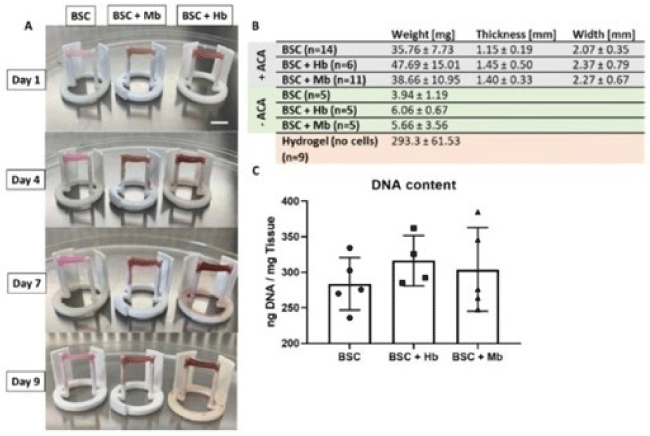 |
Adapted from Simsa et al. (2019) with CC-BY. | |
| Decompartmentalization as a simple color manipulation of plant-based marbling meat alternatives | Decompartmentalization and jackfruit-based scaffold | - The color-changing behavior of the scaffold resembled meat-like browning - Polyphenol-based color was sensitive to pH change (i.e., pH 2 and 11). 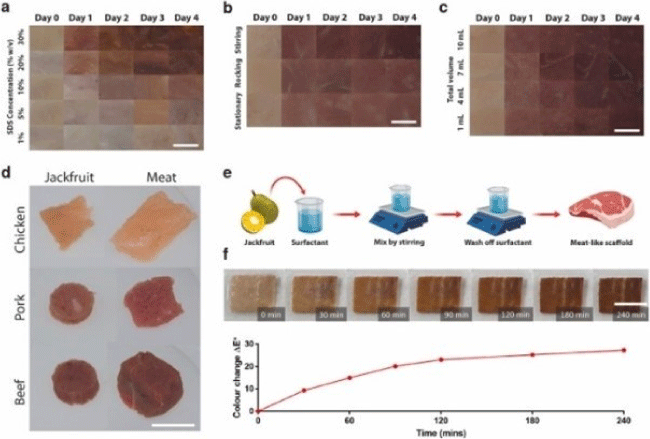 |
Adapted from Ong et al. (2021) with permission of Elsevier. | |
| Plant-based | Effect of xylose on rheological, printing, color, texture, and microstructure characteristics of 3D-printable colorant-containing meat analogs based on mung bean protein | Xylose and beet red | - Addition of approximately 0.5%–2% w/w beet root could mimic chicken, pork, and beef color - Xylose addition could affect the texture and color due to the Maillard reaction 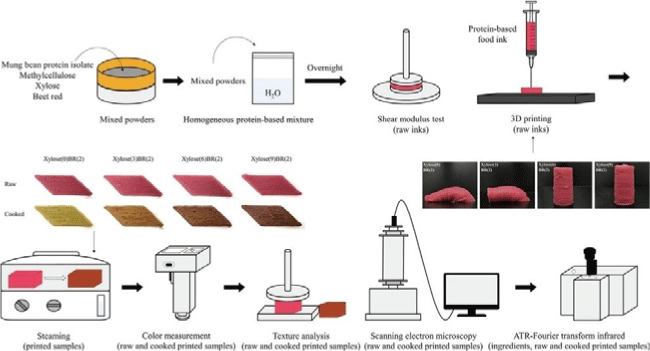 |
Adapted from Wen et al. (2022) with permission of Elsevier. |
| Effect of whole tomato powder or tomato peel powder incorporation on the color, nutritional, and textural properties of extruded high-moisture meat analogues | Tomato powder and tomato peel powder | Color change in meat analogue containing 10% w/w tomato peel powder could resemble the color change in cooking real meat - Addition of whole tomato powder in meat analogues could resemble cured-meat products 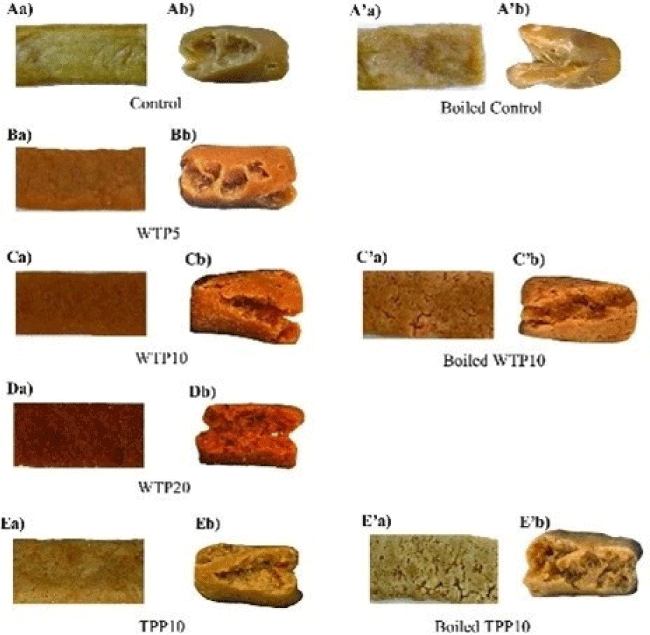 |
Adapted from Lyu et al. (2023) with CC-BY. | |
| Effects of Haematococcus pluvialis addition on the sensory properties of plant-based meat analogues | H. pluvialis | - Addition of less than 5% of H. pluvialis can improve the color of plant-based meat to beef-like red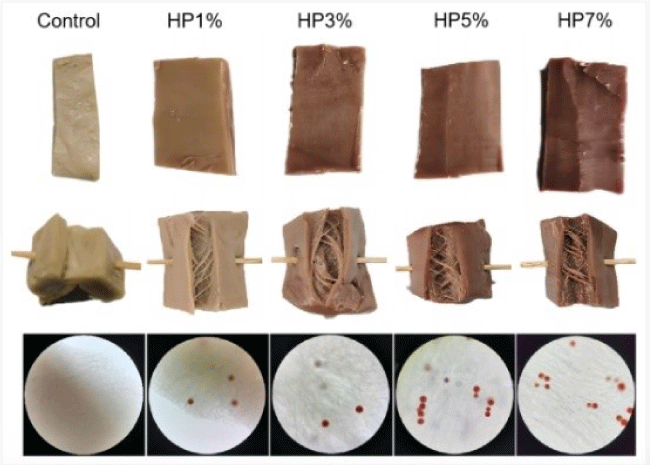 |
Adapted from Liu et al. (2023) with CC-BY. | |
| Structural and rheological properties of meat analogues from H. pluvialis residue-pea protein by high-moisture extrusion | H. pluvialis | - The addition of 10–40 g/100 g of H. pluvialis in meat analogue can induce coloration similar to dried red meat - Treatments with H. pluvialis also improved the texture after high-moisture extrusion |
Xia et al. (2022) | |
| Utilizing H. pluvialis to simulate animal meat color in high-moisture meat analogues: Texture quality and color stability | H. pluvialis | - Treatments with 1% or 0.25% H. pluvialis resembled raw beef loin and raw pork loin, respectively - Color loss was greater due to light exposure than to cooking and frozen storage 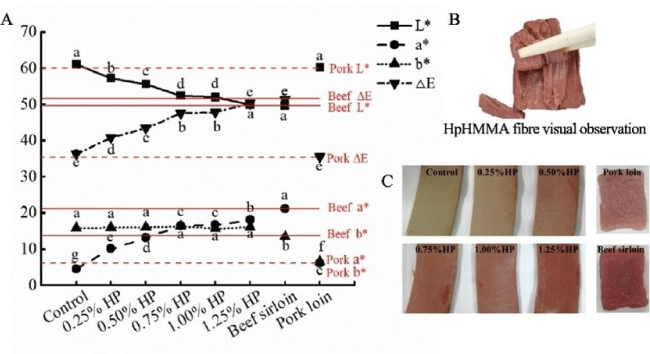 |
Adapted from Huang et al. (2024) with CC-BY. | |
| Synergistic effects of laccase and pectin on the color changes and functional properties of meat analogues containing beet red pigment | Beet red, laccase, and sugar beet pectin | - The combination of laccase and pectin beet red-containing plant-based patties resulted in a similar grilled beef patty color - Laccase and sugar beet pectin can be utilized to improve the browning system of meat analogues containing beet red 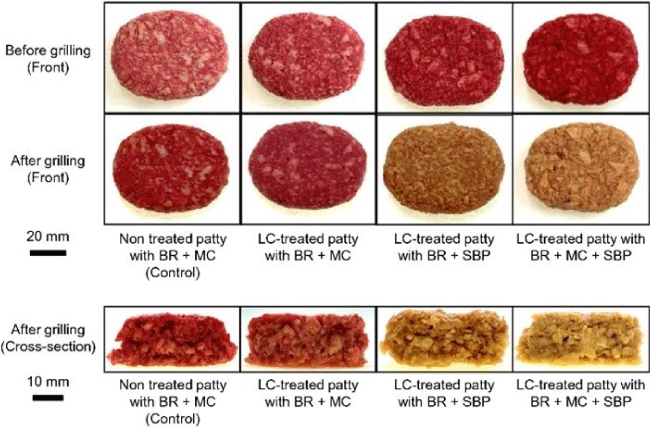 |
Adapted from Sakai et al. (2022) with CC-BY. | |
| Beetroot juices as colorant in plant-based minced meat analogues: Color, betalain composition, and antioxidant activity as affected by juice type | Beetroot juices | - Addition of cooked beet root juice in textured soy protein could mimic raw minced beef color - The combination of commercial beet juice and textured soy protein could resemble raw minced pork color 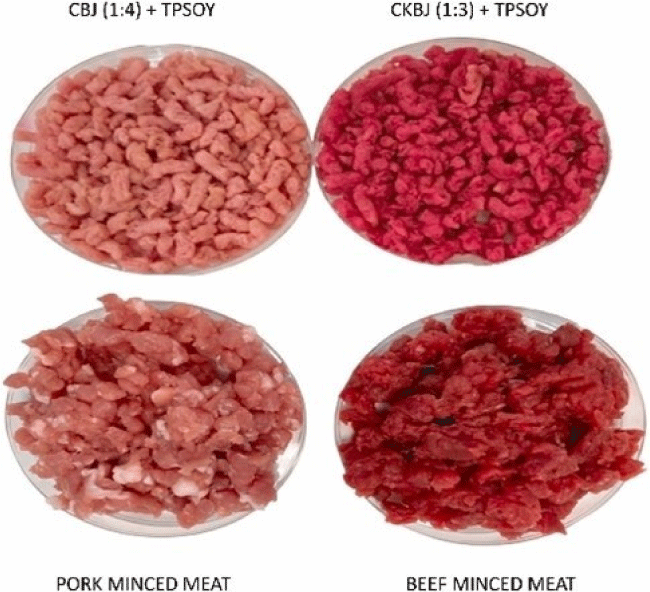 |
Adapted from Fernández-López et al. (2023) with CC-BY-NC-ND. | |
| Application of ohmic cooking to produce a soy protein-based meat analogue | Ohmic cooking and beet red | - Higher ohmic cooking temperature induces brighter internal coloration of meat analogue | Jung et al. (2022) | |
| Varying the amount of solid fat in animal fat mimetics for plant-based salami analogues influences texture, appearance, and sensory characteristics | Plant-based fat from canola, sal, and beetroot powder | - Addition of 25%–50% sal fat in meat analogue could mimic pork fat even after drying - Pasteurization induces a color change of the product from deep red to orange-red |
Dreher et al. (2021) | |
| Physicochemical properties of novel non-meat sausages containing natural colorants and preservatives | Lycopene, paprika oleoresin, and red yeast rice powder | - Superior sensory acceptance was observed for non-meat sausages containing paprika oleoresin (3 g/kg), red yeast rice (0.1 g/kg), and lycopene (0.32 g/kg) | Akramzadeh et al. (2018) | |
| Development of plant-based burgers using gelled emulsions as fat source and beetroot juice as colorant: Effects on chemical, physicochemical, appearance, and sensory characteristics | Beetroot juice | - Plant-based burgers with fresh beet juice were more susceptible to color change during cooking compared to commercial beet juice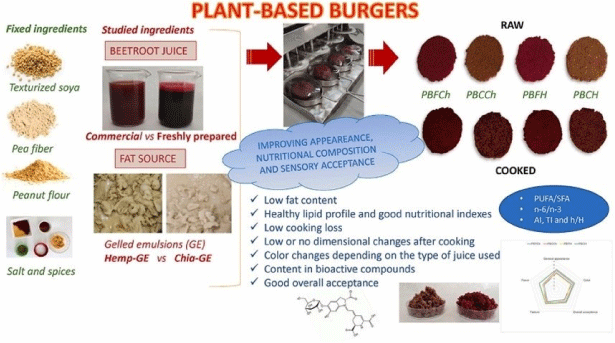 |
Adapted from Botella-Martínez et al. (2022) with CC-BY-NC-ND. | |
| Synergistic effect of lactoferrin and red yeast rice on the quality characteristics of novel plant-based meat analog patties | Lactoferrin and red yeast rice powder | - Raw treatment patties were lighter with moderate CIE b* compared to raw beef patties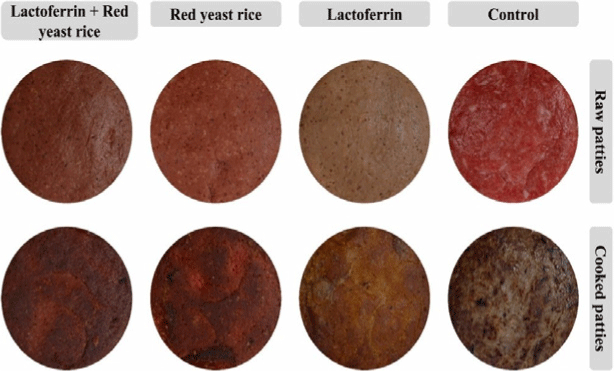 |
Adapted from Bakhsh et al. (2022) with CC-BY. | |
| Applications of various natural pigments to a plant-based meat analogue | Beet red, Monascus red, paprika oleoresin, sorghum, and cacao | - The combination of cacao (1.1–1.3 mg/g) and red beet (0.4–1.5 mg/g) showed similar coloration to Hanwoo rib patty - Single colorant in meat analogue was insufficient in mimicking the control 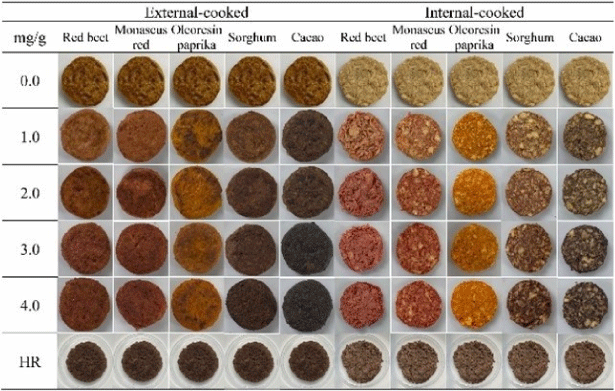 |
Adapted from Ryu et al. (2023) CC-BY-NC-ND. | |
| Characterization of plant-based meat alternatives blended with anthocyanins, chlorophyll, and various edible natural pigments | Paprika, Monascus, grape, cherry, red cabbage, and beet red | - Plant-based meat analogues with natural pigments showed lower CIE a* compared to conventional meat - Inconsistencies in the color coordinates of the treatments may be due to differences in the color of natural pigments, concentration, and substitution of plant-based protein 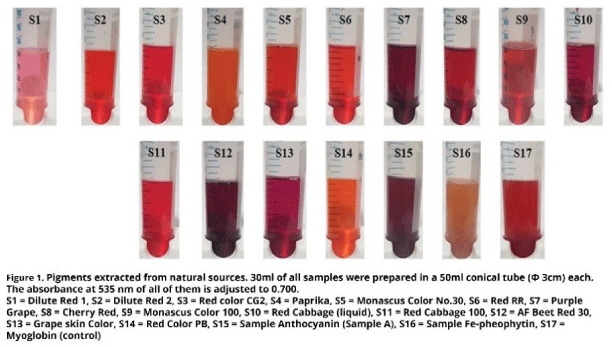 |
Adapted from Bakhsh et al. (2023) with CC-BY. | |
| Optimizing the appearance of plant-based foods using color match theory | Turmeric, beet red, butterfly pea flower | - More than three pigments should be used to mimic animal-based products | Wannasin et al. (2023) | |
| Mycoprotein | Meat substitute development from fungal protein (Aspergillus oryzae) | Beet extract and annatto | - Beet extract closely resembled real meat color - Annato showed higher saturation and CIE a* intensity, giving an artificial or unnatural appearance |
Gamarra-Castillo et al. (2022) |
| Mushroom–legume-based minced meat: Physico-chemical and sensory properties | Beet root extract | - Beet root extract can enhance mushroom-based minced meat substitutes and achieve a high sensory acceptance at 0.2% (w/w) | Mazumder et al. (2023) | |
| Mycoprotein as chicken meat substitute in nugget formulation: Physicochemical and sensorial characterization | Carrageenan | - The use of mycoprotein as chicken substitute increased the CIE a* of the product - The addition of carrageenan did not affect the CIE a* of the mycoprotein-based nuggets - White pepper, instead of black pepper, can be used to increase the CIE L* |
Hashempour-Baltork et al. (2023) |
In cell-cultivated meat, culturing bovine satellite cells with Mb showed increased proliferation and development of cooked color similar to cooked beef after cooking (Simsa et al., 2019). Furthermore, the innovative use of jackfruit-based scaffolds both imitated meat marbling and resembled the browning of meat when oxidized (Ong et al., 2021). Additionally, Wen et al. (2022) designed three-dimensional-printed meat analogues containing xylose and beet extract to imitate the color change of conventional meat.
Research on plant-based meat analogue development has determined specific or recommended amounts of natural pigments in meat analogues to achieve conventional meat-like coloration. Lyu et al. (2023) showed that the addition of 10% (w/w) tomato peel powder could provide color-changing behavior similar to conventional meat. Similarly, Sakai et al. (2022) studied the combination of laccase, pectin, and beet red pigment to simulate the color change of meat. Another study identified that the combination of cacao (1.1–1.3 mg/g) and red beet (0.4–1.5 mg/g) could produce a similar coloration to a Hanwoo rib patty (Ryu et al., 2023). However, Ryu et al. (2023) concluded that the use of a single colorant for meat analogues is not enough to mimic real meat color, and Wannasin et al. (2023) concluded that more than three pigments should be used with the aid of color match theory. Aside from terrestrial plant sources of red pigments, researchers have explored the use of microalgae, such as H. pluvialis, as a colorant for meat analogues. According to Liu et al. (2023), the addition of less than 5% (w/w) of H. pluvialis was enough to resemble beef-like red, which was similar to the reported amount of 0.25% or 1% (w/w) to imitate raw pork loin and raw beef loin, respectively (Huang et al., 2024). A relatively greater amount of 10%–40% (w/w) of H. pluvialis residue imitated the color of dried red meat (Xia et al., 2022). Additionally, Akramzadeh et al. (2018) formulated meat analogues containing carrageenan, modified cornstarch, egg white, and natural colorants (lycopene, paprika oleoresin, and red yeast rice powder) and optimized the levels of all these ingredients to yield a product with the highest overall acceptability. Bakhsh et al. (2022) also used red yeast rice as a source of color for plant-based meat.
Similar to cultivated meat, research related to mycoprotein-based analogues is limited in terms of studies involving color parameters. Gamarra-Castillo et al. (2022) compared the effect of beet extract and annatto, which resulted in the preference for beet root extract because the use of annatto could result in an artificial appearance. Beet root extract (0.2%, w/w) enhanced the color of a mushroom-based minced meat substitute, both fresh and cooked (Mazumder et al., 2023). Contrary to the need for colorants, Hashempour-Baltork et al. (2023) reported that using mycoprotein increased the CIE a* of chicken nuggets formulated with carrageenan. Moreover, it was suggested that white pepper can be used to modulate the CIE L* of the product.
Despite the focus on achieving meat-like red for meat analogues, other research focused on fat alternatives, which also contribute to the color and overall appearance of both conventional meat and meat analogues. Yen et al. (2023) developed an oleogel-based fat replacer for cultivated meat. Meanwhile, Dreher et al. (2021) focused on developing fat replacers from canola and sal. They found that the addition of 25%–50 % w/w of sal fat satisfactorily mimicked pork fat in raw and dried meat analogues. Aside from colorants, a high ohmic cooking temperature can induce improved internal coloration of meat analogues (Jung et al., 2022). Additionally, pasteurization could induce a color change in meat analogues, as observed in meat analogues with beetroot powder, which transitioned from deep red to orange-red after pasteurization (Dreher et al., 2021).
Although the addition of natural pigments is directed toward improving the sensorial characteristics of meat alternatives, the potential bioactivity of these additives should also be considered. Fernández-López et al. (2023) compared the antioxidant activities of different beetroot juices and identified that fresh-cooked beetroot juice yielded the highest antioxidant activity, attributed to the high betalain content of freshly extracted beet juice compared to commercial ones. Jin et al. (2021) revealed that pigments sourced from blueberries, cherries, onions, black tea, and clove buds had higher antioxidant activity than other plant-derived pigments and conventional meat. However, the stability of these bioactive components during meat analogue production and after cooking must be evaluated before the product can be considered a functional food.
Conclusion
The increasing interest in meat alternatives continues to engage the industry sector and researchers in the development of cultured meat and meat analogues that mimic conventional meat characteristics, including meat color. Diverse techniques can be used to achieve the desired color of meat alternatives. The use of synthetic and natural colorants presents an affordable and efficient option to modulate the color characteristics of cultured meat and meat analogues. However, the potential adverse effects of these components on human health must be considered during the formulation of food products. Thus, other color-inducing methods, such as the use of color-changing scaffolds, ohmic cooking, and pasteurization, could be used in tandem with the colorants. Furthermore, attention toward mimicking other meat components, such as fat, could improve the overall appearance of cultured meat and meat analogues and potentially increase product acceptability. Therefore, the optimization of color-inducing techniques can contribute to increasing the overall acceptability of novel meat-inspired foods.













